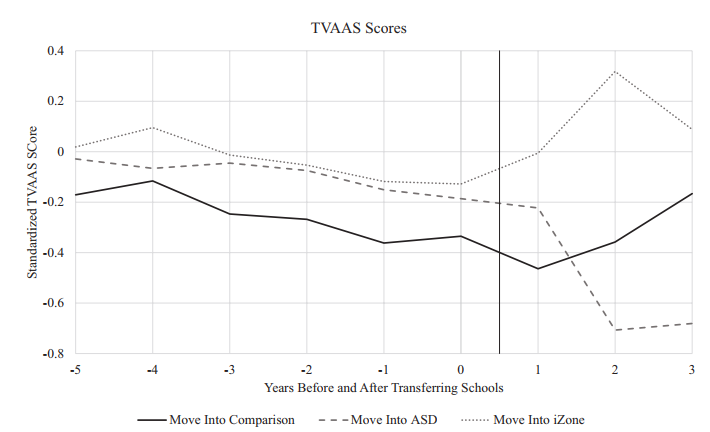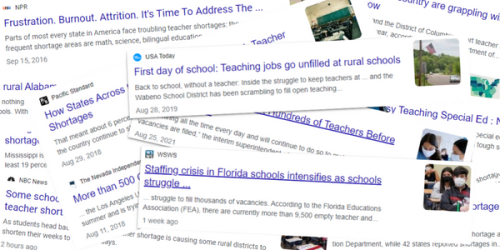Time and again, studies find that schools serving more students living in poverty and more students of color tend to have less effective teachers (recent examples here and here). But this inequity is not destiny: some districts use financial incentives and other programs to entice teachers with a track record of improving student outcomes to come to lower-performing schools and schools serving more vulnerable students (for example, the ACE program in Dallas, IMPACT in DC, and many other districts).
This approach assumes that teachers who were effective in one school will be similarly effective in another. New research by Lam D. Pham of North Carolina State University tests that assumption, looking at whether teachers moving into two types of turnaround schools remain similarly effective. The answer (perhaps less satisfying than policy wonks would like) is: It depends on the school context.
The study considers Tennessee under NCLB, when over 100 schools were identified as “priority schools” in need of intervention. Some schools closed, some kept with business as usual, but about half of these schools were revamped under one of two turnaround models: The Achievement School District (ASD) model and the innovation zone (iZone) approach. As described by Pham, the ASD focused on removing bureaucratic obstacles and decoupling the schools from its local district (so that the schools became part of a statewide district or could be run by a charter management organization; as of 2015 when this study was conducted, five ASD schools were part of the statewide district and 24 were charter or contract schools1). In the iZone approach, schools remained part of the local district, and received more intensive district support and resources. Both sets of schools had access to the state’s bonus pay system to recruit effective teachers and both sets of turnaround schools recruited more teachers with higher value-added scores than did priority schools that stuck with “business as usual.”
But, once those teachers entered their ASD or iZone schools, something interesting happened. The teachers who moved to the iZone schools became more effective (as measured by their value-added scores), while the teachers who moved to the ASD scores were initially less effective, compared to how they had performed previously.

|
Reprinted from Pham, L. D. (2022). Is Teacher Effectiveness Stable Across School Contexts? An Examination of Teachers Who Transfer into Turnaround Schools. AERA Open, 8, 23328584221139763. |
Notably, the positive effects for iZone schools were driven by Black teachers, meaning that only Black teachers had statistically significant increases in effectiveness; non-Black teachers did not see any change in effectiveness (although the author does not offer a theory as to why). At ASD schools, teachers who transferred in with higher value-added scores had a greater negative drop in math than teachers with lower value-added scores (their drop in reading was smaller and not statistically significant). No other characteristics (years of experience, advanced degrees, or tenure) seemed to make a difference.
So what might explain these divergent results? The author hypothesizes that when teachers move to a new school, they need some support adjusting (e.g., through structures such as an induction program, mentoring, and instructional teams). The iZone model placed a premium on bringing in additional support resources (e.g., classroom supplies, help with school operations), freeing school leaders’ time to focus on instruction. In contrast, the ASD schools removed many external supports (the study mentions unclear budgets and transportation plans) and had a hard time retaining school leaders, which may have increased the overall burden on leaders, reducing their attention for teachers.
This study offers important lessons for policymakers considering how to bring the most effective teachers to the students who need them most—and how to support them to continue to be effective once they arrive in their new schools. Enticing teachers to come to low-performing schools is a critical first step, but providing teachers (even those with years of experience) with support when making the transition is imperative; otherwise teachers may falter for the first few years after they make the move. Further, as school choice has again become a hot topic, this study offers some caution against separating schools from district-level supports (e.g., school transportation, budget planning, vetting curricula) without ensuring that the schools are able to replace those resources on their own.
More like this

An equity decision: Which teachers choose to teach which students?

Are some teachers more effective than others at teaching students with disabilities?

How are school districts using strategic pay to attract and retain teachers where they need them?

Building a school climate that makes teachers want to stay

Supporting teachers through mentoring and collaboration
Endnotes
- This report on the proportion of charter ASD schools explains, “Tenn. Code Ann. §§ 49-1-614(b) and 49-13-106 authorize the ASD to directly run schools, authorize charter schools, and contract with nonprofit entities to operate schools and provide services to students. Hence, contract schools are not ASD charter schools.” The report does not further define “contract schools.” Public Impact: Kim, J., Field, T., & Hargrave, E. (2015). The Achievement School District: Lessons from Tennessee. Chapel Hill, NC: Public Impact and New Orleans, LA: New Schools for New Orleans. Retrieved from http://achievementschooldistrict.org/publications/


